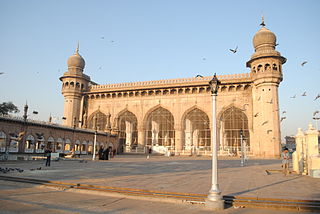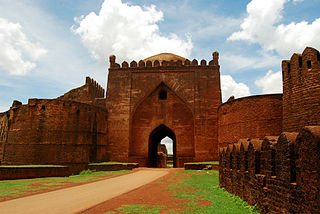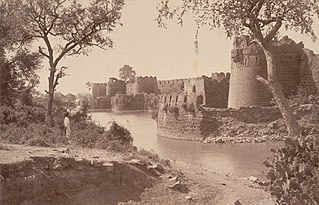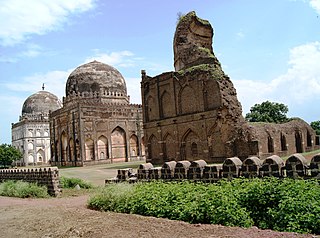
Bidar is a city and headquarters of the Bidar district in Karnataka state of India. Bidar is a prominent place on the archaeological map of India, it is well known for architectural, historical religious and rich heritage sites. Picturesquely perched on the Deccan plateau, the Bidar fort is more than 500 years old and still standing strong. According to the book "Bidar Heritage" published by the state Department of Archaeology, Museums and Heritage, of the 61 monuments listed by the department, about 30 are tombs located in and around Bidar city., explaining its nickname, "City of Whispering Monuments". The heritage sites in and around Bidar have become the major attraction for film shooting in recent years, with Bollywood making visits apart from Kannada film industry

The Moti Masjid is a 17th-century historical mosque, not open for worship, inside the Red Fort complex in North Delhi, India. It was built by Mughal emperor Aurangzeb, damaged during the Siege of Delhi, and subsequently restored by the British. Named for its white marble, the mosque features ornate floral carvings. It is an important example of Mughal architecture during Aurangzeb's reign.

Makkah Masjid or Mecca Masjid, is a congregational mosque in Hyderabad, India. It is the largest mosque in the city, and one of the largest in the country, with a capacity of 10,000 people. The mosque was built during the 17th century, and is a state-protected monument. It serves as the primary mosque for the Old City of Hyderabad, and is located close to the historic landmarks of Charminar, Chowmahalla Palace and Laad Bazaar.

The Jama Masjid, also known as Jamiya Masjid or Jumma Masjid, is a congregational mosque in Bijapur, in the state of Karnataka, India. Initiated by Ali Adil Shah I of the Bijapur Sultanate in the 16th century, the mosque was never completed. It is the largest mosque in Bijapur, and has a capacity of 4,000 worshippers.

Moth ki Mosque is a 16th-century mosque located in the South Delhi district of India. The mosque was built in 1505 by Wazir Miya Bhoiya, Prime Minister during the reign of Sikander Lodi of the Lodi dynasty. It was a new type of mosque developed by the Lodis in the fourth city of the medieval Delhi Sultanate. This mosque was considered a beautiful domed (gumbad) structure of the period.

Jahanpanah was the fourth medieval city of Delhi established in 1326–1327 by Delhi Sultan, Muhammad bin Tughlaq. To counter the persistent threat of Mongol invasions, Tughlaq constructed the fortified city of Jahanpanah, incorporating the Adilabad Fort, built in the 14th century, along with all the establishments located between Qila Rai Pithora and Siri Fort. Neither the city nor the fort has survived. Many reasons have been offered for such a situation. One of these is exemplified by the idiosyncratic rule of Mohammed bin Tughlaq, who inexplicably decreed the capital to be moved to Daulatabad in the Deccan, only to return to Delhi soon after.

Bidar Fort is located in old city area, Bidar, Karnataka, India. The fort, the city and the district are all affixed with the name Bidar. Sultan Ahmad Shah I of the Bahmanid dynasty shifted his capital from Gulbarga to Bidar in 1427 and built his fort along with a number of Islamic monuments. There are over 30 monuments inside Bidar fort.

The Gulbarga Fort is located in Kalaburagi in the Kalaburagi district of North Karnataka. The fort was originally constructed by the Hindu monarch Raja Gulchand, and it was subsequently significantly enlarged in 1347 by Ala-ud-Din Bahman Shah of the Bahmani Kingdom after he cut off his ties with the Delhi Sultanate. Islamic monuments such as mosques, palaces, tombs, and other structures were also built later within the refurbished fort. The Jama Masjid, built later within the fort in 1367, is a unique structure built in the Persian architectural style, fully enclosed with elegant domes and arched columns. It was built to commemorate the establishment of the dynastic rule of the Bahmani Kingdom at Gulbarga Fort between 1347 and 1424. It remained the capital of the Bahmani Kingdom until 1424 where after the capital was shifted to Bidar, which had better climatic conditions.

The Bijapur Fort is located in the Bijapur city in Bijapur District of the Indian state of Karnataka. Bijapur fort has a plethora of historical monuments of architectural importance built during the rule of Adil Shahi dynasty.

Toli Masjid, also known as Damri Masjid, is a mosque in Hyderabad, in the Indian state of Telangana. It was constructed during the Qutb Shahi period and completed in 1671.

The Bibi Maryam Mosque, also known as the Hajiganj Mosque, is in Hajiganj, Narayanganj. The mosque is said to have been constructed by Nawab Shaista Khan, Mughal subadar of Bengal. The construction of the mosque began in 1664 and finished in 1688. It took 24 years to complete. Bibi Maryam, apparently his daughter, is said to be buried nearby in a tomb. The mosque is a three-domed type, the central dome being more comprehensive than the side ones. The side domes are reduced by thickening the side walls instead of adding an intermediate half-dome, as seen in some Mughal mosques. The basal leaf decoration of the domes and the battlemented merlons speak of the standard style. The panel leaf decoration on the top of the roof is seen only on the front side. The eastern facade of the mosque has the usual three arched entrances, each opening under a half dome and the central one being more expansive than the side entrances. Two windows, one each on the south and north sides are of later innovation. The four engaged corner towers, almost merged within the wall, are extended beyond the parapet. The interior hall shows simple lateral arches. The side bays are made square by thickening the side walls. The mosque has been repaired and renovated several times. It has significantly lost much of its original features through repairs since the corner towers are being wholly modernised. A veranda on masonry pillars on the eastern side has completely overshadowed the front view. It is now being used as a Jami mosque.

The Mahmud Gawan Madrasa is a former madrasa, now mosque, in partial ruins, located in Bidar, in the state of Karnataka, India. It was completed in AH 876 (1471/1472 CE) and is an example of the regional style of Indo-Islamic architecture under the Bahmani Sultanate. Founded by the prime-minister of the sultanate in the late 15th century, it bears testimony to the scholarly genius of Mahmud Gawan, who first came to Delhi, in exile, as a Persian trader from Gilan in Iran and moved to Bidar in 1453.

The Qila-i-Kuhna Mosque, also known as the Mosque of Sher Shah and the Kila Kohna Masjid, is an Hanafi Sunni, mosque located inside the Purana Qila of Central Delhi, India.

The Bahmani tombs complex at Bidar is the necropolis of the Bahmani dynasty, located in Bidar, in the Indian state of Karnataka.

The Kali Masjid is a mosque in the town of Bidar, in the state of Karnataka, India.

The Mecca Masjid, also known as Makka Masjid, is a mosque located in the Vijayapura district of Bijapur, in the state of Karnataka, India. Believed to be completed in c. 1669, the mosque was built for women of the royal household.

The Jama Masjid is a Friday mosque in Bidar, in the state of Karnataka, India.

The Langar Ki Masjid, also known as Langar Masjid or Langar Mosque, is a former mosque, now in partial ruins, situated in Kalaburagi, in the state of Karnataka, India. The former mosque is a state protected monument.

The Ali Farhad Khan's Mosque, also known as Kali Masjid, is a mosque and dargah, located in Aland, in the state of Karnataka, India. The mosque structure is a state protected monument.

Andu Masjid, also known as Anda Masjid, is a mosque located in Bijapur, in the Indian state of Karnataka. It is listed as a monument of national importance.

























